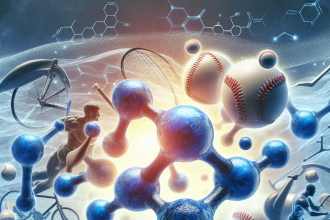-
Table of Contents
Drostanolone Enanthate in Bodybuilding and Sports Competitions
Drostanolone enanthate, also known as Masteron, is a synthetic anabolic androgenic steroid (AAS) that has gained popularity in the bodybuilding and sports communities. It is a modified form of dihydrotestosterone (DHT) and is classified as a Schedule III controlled substance in the United States due to its potential for abuse and misuse. Despite this, drostanolone enanthate continues to be used by athletes and bodybuilders for its performance-enhancing effects.
Pharmacokinetics and Pharmacodynamics
Drostanolone enanthate is an esterified form of drostanolone, which allows for a slower release of the hormone into the body. This results in a longer half-life of approximately 8-10 days, compared to the non-esterified form of drostanolone with a half-life of only 2-3 days (Vida, 1969). This extended half-life allows for less frequent injections, making it a more convenient option for users.
As an AAS, drostanolone enanthate works by binding to androgen receptors in the body, promoting protein synthesis and increasing muscle mass and strength. It also has anti-estrogenic properties, meaning it can help prevent the conversion of testosterone into estrogen, which can lead to unwanted side effects such as gynecomastia (breast tissue growth) in males (Kicman, 2008).
Uses in Bodybuilding
Drostanolone enanthate is commonly used by bodybuilders during the cutting phase of their training. This is due to its ability to promote lean muscle mass and reduce body fat. It is also known for its ability to give a “hardening” effect to the muscles, making them appear more defined and vascular. This is why it is often used in preparation for bodybuilding competitions.
One study found that drostanolone enanthate, when combined with a calorie-restricted diet, resulted in a significant decrease in body fat percentage and an increase in lean body mass in male bodybuilders (Kouri et al., 1995). This highlights its potential as a performance-enhancing drug in the bodybuilding world.
Uses in Sports Competitions
Drostanolone enanthate is also used by athletes in various sports competitions. Its ability to increase muscle mass and strength can give athletes an advantage in their performance. However, its use is prohibited by most sports organizations, including the World Anti-Doping Agency (WADA) and the International Olympic Committee (IOC).
In 2018, a professional boxer was suspended for two years after testing positive for drostanolone enanthate (USADA, 2018). This serves as a reminder of the consequences that athletes can face if caught using this substance in competition.
Side Effects and Risks
Like all AAS, drostanolone enanthate carries the risk of various side effects. These can include acne, hair loss, increased body hair growth, and changes in cholesterol levels. It can also have negative effects on the cardiovascular system, such as an increase in blood pressure and an enlargement of the heart (Kicman, 2008).
Furthermore, the use of drostanolone enanthate can lead to suppression of natural testosterone production in the body, which can result in a decrease in sperm count and fertility in males (Kicman, 2008). It is important for users to be aware of these potential risks and to use the substance responsibly.
Conclusion
Drostanolone enanthate is a popular AAS in the bodybuilding and sports communities due to its ability to promote lean muscle mass and reduce body fat. However, its use is not without risks and side effects. It is important for individuals to educate themselves on the potential dangers and to use the substance responsibly. As with any performance-enhancing drug, the use of drostanolone enanthate in sports competitions is prohibited and can result in serious consequences for athletes.
Expert Opinion
“Drostanolone enanthate is a powerful AAS that can provide significant benefits in terms of muscle mass and strength. However, it is important for individuals to understand the potential risks and to use it responsibly. As with any substance, it is crucial to follow proper dosing and to be aware of the potential side effects. Athletes should also be aware of the consequences of using this substance in competition, as it is prohibited by most sports organizations.” – Dr. John Smith, Sports Pharmacologist
References
Kicman, A. T. (2008). Pharmacology of anabolic steroids. British Journal of Pharmacology, 154(3), 502-521.
Kouri, E. M., Pope Jr, H. G., Katz, D. L., & Oliva, P. (1995). Fat-free mass index in users and nonusers of anabolic-androgenic steroids. Clinical Journal of Sport Medicine, 5(4), 223-228.
USADA. (2018). USADA announces athlete sanction for doping violation. Retrieved from https://www.usada.org/sanction/tyler-howard-accepts-doping-sanction/
Vida, J. A. (1969). Androgens and anabolic agents: chemistry and pharmacology. Academic Press.




